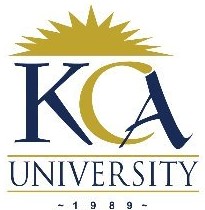 UNIVERSITY EXAMINATIONS: 2011/2012
UNIVERSITY EXAMINATIONS: 2011/2012
THIRD YEAR EXAMINATION FOR THE BACHELOR OF
SCIENCE IN INFORMATION TECHNOLOGY
BIT 3103 FOUNDATION OF LEARNING ADAPTIVE SYSTEMS
DATE: AUGUST, 2012 TIME: 2 HOURS
INSTRUCTIONS: Answer Question ONE and any other TWO
QUESTION ONE
a) Briefly explain the following terms.
i. Perceptron (2 Marks)
ii. Delta rule (2 Marks)
iii. Activation function (2 Marks)
b) Describe four situations that are appropriate Machine learning systems
application (4 Marks)
c) Describe any three disciplines that contributes to machine learning (3 Marks)
d) Briefly explain four limitations of using artificial neural networks in learning and
adaptive systems. (4 Marks)
e) Describe the term ‘rote learning’. State and explain any three possible
applications of rote learning in modern society (5 Marks)
f) Briefly explain the steps of K-nearest neighbour algorithm in the context of
learning adaptive systems. Give one example to illustrate your answer.
(5 Marks)
g) Describe three elements that required by k-nearest neighbour algorithm.
(3 Marks)
QUESTION TWO
a) Briefly explain the following concepts
i. Inductive learning (2 Marks)
ii. Hebbian Learning Rule (2 Marks)
iii. Hypothesis (2 Marks)
b) Describe four challenges of implementing machine learning systems (4 Marks)
c) Describe the meaning of the term ‘hamming distance’. Use the following to
compute hamming distance between Monday and Wednesday (4 Marks)

d) Briefly explain the algorithm for clustering as used in learning and adaptive
systems (4 Marks)
e) Briefly explain the criteria of stopping decision tree learning (2 Marks)
QUESTION THREE
a) Briefly explain the following concepts in the context of learning and adaptive
systems
i. Fitness score (2 Marks)
ii. Mutation operator (2 Marks)
b) Briefly explain four criteria of evaluating learning algorithm (4 Marks)
c) Briefly explain steps of basic genetic algorithms as used in learning adaptive
systems (4 Marks)
d) Describe the term ‘encoding methods’ as used in genetic algorithms. Briefly
explain three encoding methods and give one example for each case (8 Marks)
QUESTION FOUR
a) Describe the meaning of the term ‘artificial neural network’ as used in learning
and adaptive systems. (2 Marks)
b) Briefly explain learning process in artificial neural networks (3 Marks)
c) A fully- connected, feed forward network has four input nodes and one hidden
layer of two neurons. The network has a four output neurons. Construct a graph
that visually describes this network. (4 Marks)
d) Briefly explain four limitations of using artificial neural network (4 Marks)
e) Define what is ‘over fitting’. Describe two methods that are used to avoid over
fitting in decision trees learning. (4 Marks)
f) Explain the meaning of the term ‘thresh hold’. Describe its importance in neural
Networks. Give one example to illustrate your answer (3 Marks)
QUESTION FIVE
a) Briefly explain the following terms
i. Reinforcement learning (2 Marks)
ii. Information gain (2 Marks)
b) Describe what is ‘case based reasoning’. Briefly explain any three applications of
case based reasoning (5 Marks)
c) Describe three assumptions of case based reasoning (3 Marks)
d) State and explain case based reasoning cycle as used learning and adaptive
systems (4 Marks)
e) State and explain four elements of a reinforcement learning system: (4 Marks)
